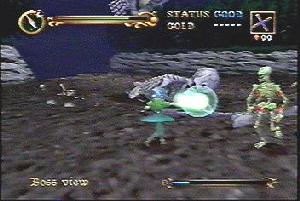Whip it Good!
The townspeople of Wallachia, Transylvania, aren’t sleeping well tonight. Besides being in a backwater part of the world, their forefathers thought nothing of building their village next to the imposing castle of Count Dracula. The Belmont clan had rid the land of its ancient evil for centuries, and it has been over one hundred years since Dracula had been defeated. But now, a shadow has crept across the land and Count Dracula has returned from his banishment. Cursed to eternal life, he roams the countryside feasting on young maidens once again. This time, two warriors stepped into the light of goodness and vowed to stop the lord of evil. Maybe this time, he’ll stay gone.
Not likely. The Castlevania series shows no signs of decreased popularity despite the number of sequels. The reason is that all the games up to this point have built upon the previous legacy of good gameplay. Unfortunately, that string of quality games ends with Castlevania 64. With repetitive gameplay and almost no depth, you’re better off letting Dracula ravage the countryside. Might help lower global population numbers . . .
Castlevania 64 is the first in the series to leave the side-scrolling genre. Although 3D platform games are relatively popular, one must question this move due to the popular success of Castlevania: Symphony of the Night for the Playstation. SOTN was full of depth and character, and despite being a bit too short was one of the best games around.
This game, however, is not. Though the graphics are good, the color palette seems too pastel (a problem with a lot of N64 titles). While pastel colors may work in a game like Banjo-Kazooie, it just doesn’t work for a game that’s supposed to be dark and gothic.
On top of that, the camera is barely tolerable. Acting like a 7 year-old on Pixie Stix, the camera will occasionally just go nuts, running around the character. Getting a good view of the action is almost impossible, so players find themselves just making due with a bad camera angle. This, of course, often leads to death.
You can choose from one of two characters. Although initially the game was supposed to have more, Konami felt the need to rush Castlevania 64 to the market. The two characters are Reinhardt Schneider, heir to the Belmont clan and possessor of the holy whip, and Carrie Fernandez, a young girl who is gifted with magical powers (aren’t they always?). One might wonder what a Spaniard is doing in Transylvania in the 19th century, but we don’t even get that much of a plot. The only significant difference between the two characters lies with where you can go. Reminiscent of the Resident Evil 2 setup, each character has a slightly different quest.

The gameplay, arguably the mainstay of the Castlevania series, just doesn’t match up to its predecessors. Castlevania: Symphony of the Night had literally hundreds of weapons, armor, spells, and more that added amazing depth to the game. In Castlevania 64, you have two main weapons and the ability to use one special weapon. Interestingly, this was the exact setup of the original Castlevania. Apparently the designers thought that the technology hasn’t progressed since the mid-eighties. Gameplay consists of killing endless skeletons, jumping, flipping switches, killing more skeletons, jumping, killing an occasional other creature (oh, and some skeletons), backtracking, and getting bored to tears. The gameplay isn’t outright bad, but it is distinctly unexciting.
The game would be salvageable, for the most part, if it wasn’t for the control. Besides the aforementioned camera problems, the control itself is a little frisky. Since jumping is such a necessary part of the gameplay, you’d imagine that it would be easy to control. Not so, gentle reader. Most of the control problems are found in the speed of the character. Moving close to an edge in order to jump to a lower platform is tedious – you end up mastering the lemming dive before you are able to do it with some degree of success. The characters also seem to glide like Gumby over the land, as if the movement engine was the last part they implemented. Though there are no real bugs with the control, it gets more frustrating than you’d ever believe.
The good points of the game are few, but noticeable. The mood established by the game rivals older Castlevania games. The music in Castlevania 64 is good and adds to the overall creepy feeling of the game. Some of the boss characters are also well done. In particular, the first boss (the skeleton of Mighty Joe Young) is quite impressive. The potential of Castlevania 64 can be seen in small flashes, at times.
Unfortunately, those flashes are too few and far between to save the game. What was attempted with Castlevania 64 is obvious, but it fell far short of its mark. Much of this may have to do with Konami rushing it to the market before it was finished, but I have to review the product I’m given. Castlevania 64 pales in comparison to its cousins and is not worth the money to buy.
-
Decent Graphics
-
High Potential
-
Bad Control
-
Horrible Camera
-
No Depth
-
Boring and Repetitive










